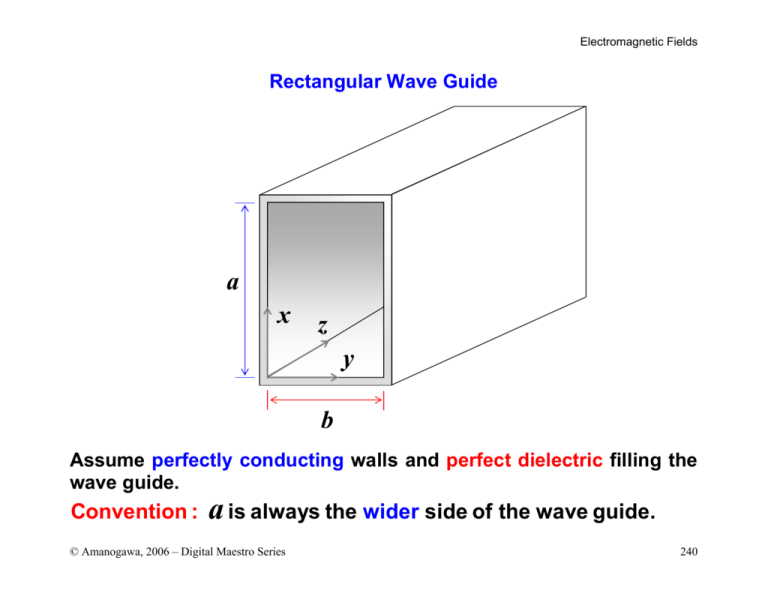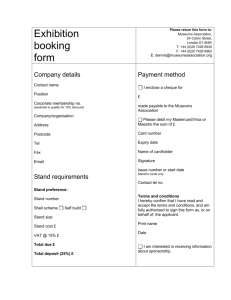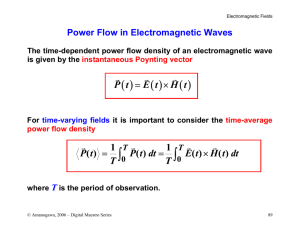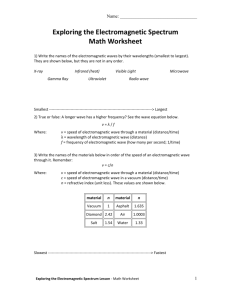a b x y - Amanogawa
advertisement

Electromagnetic Fields
Rectangular Wave Guide
a
x
z
y
b
Assume perfectly conducting walls and perfect dielectric filling the
wave guide.
Convention :
a is always the wider side of the wave guide.
© Amanogawa, 2006 – Digital Maestro Series
240
Electromagnetic Fields
It is useful to consider the parallel plate wave guide as a starting
point. The rectangular wave guide has the same TE modes
corresponding to the two parallel plate wave guides obtained by
considering opposite metal walls
E
a
E
b
TEm0
© Amanogawa, 2006 – Digital Maestro Series
TE0n
241
Electromagnetic Fields
The TE modes of a parallel plate wave guide are preserved if
perfectly conducting walls are added perpendicularly to the electric
field.
E
H
The added metal plate does
not disturb normal electric
field and tangent magnetic
field.
On the other hand, TM modes of a parallel plate wave guide
disappear if perfectly conducting walls are added perpendicularly to
the magnetic field.
H
E
© Amanogawa, 2006 – Digital Maestro Series
The magnetic field cannot
be normal and the electric
field cannot be tangent to a
perfectly conducting plate.
242
Electromagnetic Fields
TEmn
TMmn
The remaining modes are TE and TM modes bouncing off each wall,
all with non-zero indices.
© Amanogawa, 2006 – Digital Maestro Series
243
Electromagnetic Fields
We have the following propagation vector components for the
modes in a rectangular waveguide
β 2 = ω 2 µ ε = β x2 + β 2y + β z2
mπ
nπ
;
βx =
βy =
a
b
2
2
2π
2 2π
β z = = = ω 2 µ ε − β x2 − β 2y
λz
λg
2
2
π
π
m
n
= ω 2µ ε −
−
a
b
At cut-off we have
2
2
m
π
n
π
β z2 = 0 = ( 2π fc ) 2 µ ε −
−
a
b
© Amanogawa, 2006 – Digital Maestro Series
244
Electromagnetic Fields
The cut-off frequencies for all modes are
2
m
n
fc =
+
b
2 µε a
1
2
with cut-off wavelengths
λc =
2
2
2
m
n
+
a
b
with indices
TE modes m = 0, 1, 2, 3,…
n = 0, 1, 2, 3,…
(but m = n = 0 not allowed)
© Amanogawa, 2006 – Digital Maestro Series
TM modes m = 1, 2, 3,…
n = 1, 2, 3,…
245
Electromagnetic Fields
The guide wavelengths and guide phase velocities are
2π
2π
=
λg = λz =
βz
=
mπ
nπ
−
ω µε −
a
b
2
λ
λ
1−
λc
ω
1
v pz =
=
βz
µε
© Amanogawa, 2006 – Digital Maestro Series
2
2
2
=
λ
=
fc
1−
f
1
λ
1−
λc
2
2
=
1
µε
1
fc
1−
f
2
246
Electromagnetic Fields
The fundamental mode is the TE10 with cut-off frequency
fc ( TE10 ) =
m
2a µ ε
The TE10 electric field has only the y-component. From Ampere’s
law
∇ × E = − jω µ H
⇓
∂
iˆy
iˆx
∂
∂
det
∂x
∂y
Ex = 0 E y
Ez −
∂
E y = − jω µ H x
∂y
∂z
∂
∂
∂
Ex −
E z = − jω µ H y = 0
⇒
∂x
∂z
∂z
E z = 0
∂
∂
iˆz
∂x
© Amanogawa, 2006 – Digital Maestro Series
Ey −
∂y
E x = − jω µ H z
247
Electromagnetic Fields
The complete field components for the TE10 mode are then
π x − jβ z ⋅z
E y = Eo sin e
a
βz
π x − jβ z ⋅z
1 ∂E y − j β z
=
Eo sin e
Ey = −
Hx =
jω µ ∂ z
jω µ
ωµ
a
1 ∂E x
j π
π x − jβ z ⋅z
Eo cos e
Hz = −
=
jω µ ∂ z ω µ a
a
with
π
βz = ω µ ε −
a
2
© Amanogawa, 2006 – Digital Maestro Series
2
248
Electromagnetic Fields
The time-average power density is given by the Poynting vector
{
( )
}
πx
1
*
P (t ) = Re E × H = Re{Eo sin
a
2
2
1
(−
βz
ωµ
*
Eo sin
( )
πx
a
e
jβ z ⋅z
( )
ix −
H
j π
ωµ a
e
E
*
Eo cos
− jβ z ⋅z
( )
πx
a
iy ×
e
jβ z ⋅z
iz )}
*
( ) ( )
2
E 2 β
E
π
x
πx
πx
2
o
z
o π
iz − j
sin
si n
cos
ix
= Re
a
ωµa
a
a
2
ω µ
1
2
( )
Eo β z
2 πx
=
sin
a
2ω µ
iz
© Amanogawa, 2006 – Digital Maestro Series
249
Electromagnetic Fields
The resulting time-average power density flow is space-dependent
on the cross-section (varying along x, uniform along y)
2
Eo β z 2 π x
sin iz
P (t ) =
2ω µ
a
The total transmitted power for the TE10 mode is obtained by
integrating over the cross-section of the rectangular wave guide
a
b
Ptot (t ) =
dx dy
0
0
∫
∫
Eo
2
βz
2ω µ
sin
( )
2 πx
a
=
Eo
2
βz
a π
b
sin 2 ( u ) du =
π 0
2ω µ
∫
=b
=
Eo
2
βz
2ω µ
b
ab 1
u−
π 2
π
sin 2u
4
0
1
=
Eo
2
βz
4ω µ
ab =
1
Eo
2
2
2
βz
ωµ
average 1 η
TE
2
|E( x , y )|
© Amanogawa, 2006 – Digital Maestro Series
ab
area
250
Electromagnetic Fields
The rectangular waveguide has a high-pass behavior, since signals
can propagate only if they have frequency higher than the cut-off
for the TE10 mode.
For mono-mode (or single-mode) operation, only the fundamental
TE10 mode should be propagating over the frequency band of
interest.
The mono-mode bandwith depends on the cut-off frequency of the
second propagating mode. We have two possible modes to
consider, TE01 and TE20
fc (TE01 ) =
fc (TE20 ) =
© Amanogawa, 2006 – Digital Maestro Series
1
2b µ ε
1
a µε
= 2 fc (TE10 )
251
Electromagnetic Fields
a
b=
⇒
2
If
fc ( TE01 ) = fc ( TE20 ) = 2 fc ( TE10 ) =
1
a µε
Mono-mode bandwidth
fc ( TE10 )
0
a
⇒
a> b>
2
If
fc ( TE20 ) f
fc ( TE01 )
fc ( TE10 ) < fc ( TE01 ) < fc ( TE20 )
Mono-mode bandwidth
0
© Amanogawa, 2006 – Digital Maestro Series
fc ( TE10 )
fc ( TE01 ) fc ( TE20 ) f
252
Electromagnetic Fields
If
0
a
b<
⇒
2
fc ( TE20 ) < fc ( TE01 )
Mono-mode bandwidth
fc ( TE10 )
f
fc ( TE20 ) fc ( TE01 )
In practice, a safety margin of about 20% is considered, so that the
useful bandwidth is less than the maximum mono-mode bandwidth.
This is necessary to make sure that the first mode (TE10) is well
above cut-off, and the second mode (TE01 or TE20) is strongly
evanescent.
Safety margin
Useful bandwidth
0
fc ( TE10 )
© Amanogawa, 2006 – Digital Maestro Series
f
fc ( TE20 ) fc ( TE01 )
253
Electromagnetic Fields
a= b
If
(square wave guide)
0
⇒
fc ( TE10 )
fc ( TE01 )
fc ( TE10 ) = fc ( TE01 )
fc ( TE20 ) f
fc ( TE02 )
In the case of perfectly square wave guide, TEm0 and TE0n modes
with m=n are degenerate with the same cut-off frequency.
Except for orthogonal field orientation, all other properties of
degenerate modes are the same.
© Amanogawa, 2006 – Digital Maestro Series
254
Electromagnetic Fields
Example - Design an air-filled rectangular waveguide for the
following operation conditions:
a) 10 GHz is the middle of the frequency band (single-mode
operation)
b) b = a/2
The fundamental mode is the TE10 with cut-off frequency
c 3 × 10 8
fc (TE10 ) =
=
≈
Hz
2a
2a ε o µo 2a
1
For b=a/2, TE01 and TE20 have the same cut-off frequency.
c c 2 c 3 × 10 8
fc (TE01 ) =
=
=
= ≈
Hz
a
2b ε o µo 2b 2 a a
1
c 3 × 10 8
fc (TE20 ) =
= ≈
Hz
a
a ε o µo a
1
© Amanogawa, 2006 – Digital Maestro Series
255
Electromagnetic Fields
The operation frequency can be expressed in terms of the cut-off
frequencies
fc (TE01 ) − fc (TE10 )
f = fc (TE10 ) +
2
fc (TE10 ) + fc (TE01 )
=
= 10.0 GHz
2
8
8
×
×
1
3
10
3
10
⇒ 10.0 × 109 =
+
2 2 a
a
⇒ a = 2.25 × 10
© Amanogawa, 2006 – Digital Maestro Series
−2
m
a
b = = 1.125 × 10 −2 m
2
256
Electromagnetic Fields
Maxwell’s equations for TE modes
Since the electric field must be transverse to the direction of
propagation for a TE mode, we assume
Ez = 0
In addition, we assume that the wave has the following behavior
along the direction of propagation
e
− jβ z ⋅ z
In the general case of TEmn modes it is more convenient to start
from an assumed intensity of the z-component of the magnetic field
(
)
H z = H o cos ( β x ⋅ x ) cos β y ⋅ y e− j β z ⋅ z
mπ
= H o cos
a
© Amanogawa, 2006 – Digital Maestro Series
nπ
x cos
b
y e− j β z ⋅ z
257
Electromagnetic Fields
Faraday’s law for a TE mode, under the previous assumptions, is
∇ × E = − jω µ H
⇓
iˆx
∂
det
∂ x
E x
iˆy
∂
∂y
Ey
iˆz
∂
∂ z
0
© Amanogawa, 2006 – Digital Maestro Series
∂
− E y = j β z E y = − jω µ H x (1)
∂z
∂
E x = − j β z E x = − jω µ H y (2)
⇒
∂z
∂
∂
E y − E x = − jω µ H z (3)
∂x
∂y
258
Electromagnetic Fields
Ampere’s law for a TE mode, under the previous assumptions, is
∇ × H = jω ε E
⇓
iˆx
∂
det
∂ x
H x
iˆy
∂
∂y
Hy
iˆz
∂
∂z
H z
© Amanogawa, 2006 – Digital Maestro Series
∂
H z + j β z H y = jω ε E x (4)
∂y
∂
⇒ − j β z H x − H z = jω ε E y (5)
∂x
∂
∂
H y − H x = jω ε E z = 0 (6)
∂x
∂y
259
Electromagnetic Fields
From (1) and (2) we obtain the characteristic wave impedance for
the TE modes
Ey ω µ
Ex
=−
=
= ηTE
Hy
Hx βz
At cut-off
2
2
m n
β z = 0 ⇒ 2 fc µ ε = +
a b
vp
1
2
fc =
=
⇒ λc =
2
2
λc λc µ ε
m
n
+
a b
© Amanogawa, 2006 – Digital Maestro Series
260
Electromagnetic Fields
In general,
2
2
2
2
4
m
π
n
π
π
λ
2
1−
βz = ω µ ε −
− =
λ
a b
( 2π )2 λc2
⇒ βz =
2π
λ
λ
1−
λc
2
and we obtain an alternative expression for the characteristic wave
impedance of TE modes as
2 −1 2
λ
ωµ
= ηo 1 −
ηTE =
λc
βz
© Amanogawa, 2006 – Digital Maestro Series
261
Electromagnetic Fields
From (4) and (5) we obtain
∂
H z + j β z H y = jω ε E x = jω ε ⋅ηTE H y
∂y
∂H z
∂H z
1
1
=
Hy =
ωµ
jω ε ⋅ηTE − j β z ∂ y
− jβ z ∂ y
jω ε ⋅
βz
2
∂H z
λc ∂H z
β
⇒ Hy = − 2
=
−
j
z
2 ∂y
π
2
∂y
β − βz
jβ z
∂
− j β z H x − H z = jω ε E y = − jω ε ηTE H x
∂x
2
∂H z
λc ∂H z
⇒ Hx = − 2
= − jβ z
2 ∂x
2π ∂ x
β − βz
jβ z
© Amanogawa, 2006 – Digital Maestro Series
262
Electromagnetic Fields
We have used
2
λ
c
=
=
=
2
2
2
2
2
2 2π
β − β z β x + β y mπ nπ
+
1
1
1
a
b
The final expressions for the magnetic field components of TE
modes in rectangular waveguide are
2
mπ λc
mπ
H x = jβ z
H o sin
a 2π
a
nπ
x cos
b
y e− j β z ⋅ z
2
λ
nπ c
mπ
H y = jβ z
H o cos
b 2π
a
mπ
nπ
nπ
x sin
b
y e− j β z ⋅ z
x cos
y e− j β z ⋅ z
H z = H o cos
a
b
© Amanogawa, 2006 – Digital Maestro Series
263
Electromagnetic Fields
The final electric field components for TE modes in rectangular
wave guide are
E x = ηTE H y
2
nπ λc
mπ
= jηTE β z
H o cos
b 2π
a
E y = −ηTE H x
2
nπ
x sin
b
mπ λc
mπ
= − jηTE β z
H o sin
a 2π
a
Ez = 0
© Amanogawa, 2006 – Digital Maestro Series
y e− j β z ⋅ z
nπ
x cos
b
y e− j β z ⋅ z
264
Electromagnetic Fields
Maxwell’s equations for TM modes
Since the magnetic field must be transverse to the direction of
propagation for a TM mode, we assume
Hz = 0
In addition, we assume that the wave has the following behavior
along the direction of propagation
e− j β z ⋅ z
In the general case of TMmn modes it is more convenient to start
from an assumed intensity of the z-component of the electric field
(
)
E z = Eo cos ( β x ⋅ x ) cos β y ⋅ y e− j β z ⋅ z
mπ
= Eo cos
a
© Amanogawa, 2006 – Digital Maestro Series
nπ
x cos
b
y e− j β z ⋅ z
265
Electromagnetic Fields
Faraday’s law for a TM mode, under the previous assumptions, is
∇ × E = − jω µ H
⇓
iˆx
∂
det
∂ x
E x
iˆy
∂
∂y
Ey
iˆz
∂
∂ z
E z
© Amanogawa, 2006 – Digital Maestro Series
⇒
∂
E z + j β z E y = − jω µ H x (1)
∂y
∂
− jβ z E x −
E z = − jω µ H y (2)
∂x
∂
∂
E y − E x = − jω µ H z (3)
∂x
∂y
266
Electromagnetic Fields
Ampere’s law for a TM mode, under the previous assumptions, is
∇ × H = jω ε E
⇓
iˆx
∂
det
∂ x
H x
iˆy
∂
∂y
Hy
iˆz
∂
∂ z
0
© Amanogawa, 2006 – Digital Maestro Series
⇒
j β z H y = jω ε E x
(4)
− j β z H x = jω ε E y
(5)
∂
∂
H y − H x = jω ε E z
∂x
∂y
(6)
267
Electromagnetic Fields
From (4) and (5) we obtain the characteristic wave impedance for
the TM modes
E y βz
Ex
=−
=
= ηTM
Hy
Hx ω ε
We can finally express the characteristic wave impedance
alternatively as
λ
βz
= ηo 1 −
ηTM =
ωε
λc
2
Note once again that the same cut-off conditions, found earlier for
TE modes, also apply for TM modes.
© Amanogawa, 2006 – Digital Maestro Series
268
Electromagnetic Fields
From (1) and (2) we obtain
Ey
∂
E z + j β z E y = − jω µ H x = jω µ ⋅
ηTM
∂y
∂E z
∂E z
1
1
=
Ey =
ωε
jω µ / ηTM − j β z ∂ y
jω µ ⋅
− jβ z ∂ y
βz
2
∂E z
λc ∂E z
⇒ Ey = − 2
= − jβ z
2 ∂y
2π ∂ y
β − βz
jβ z
Ex
∂
− j β z E x − E z = − jω µ H y = − jω µ
∂x
ηTM
2
∂E z
λc ∂E z
⇒ Ex = − 2
= − jβ z
2 ∂x
2π ∂ x
β − βz
jβ z
© Amanogawa, 2006 – Digital Maestro Series
269
Electromagnetic Fields
The final expressions for the electric field components of TM modes
in rectangular waveguide are
2
mπ λc
mπ
E x = − jβ z
Eo cos
a 2π
a
nπ
x sin
b
y e− j β z ⋅ z
nπ λc
mπ
nπ
E y = − jβ z
x cos
Eo sin
b 2π
a
b
mπ nπ − j β z ⋅ z
E z = Eo sin
x sin
y e
a b
y e− j β z ⋅ z
2
© Amanogawa, 2006 – Digital Maestro Series
270
Electromagnetic Fields
The final magnetic field components for TM modes in rectangular
wave guide are
H x = − E y / ηTM
β z nπ λc 2
mπ
= j
Eo sin
ηTM b 2π
a
H y = E x / ηTM
nπ
x cos
b
β z mπ λc 2
mπ
=−j
Eo cos
ηTM a 2π
a
y e− j β z ⋅ z
nπ
x sin
b
y e− j β z ⋅ z
Hz = 0
Note: all the TM field components are zero if either βx=0 or βy=0.
This proves that TMmo or TMon modes cannot exist in the
rectangular wave guide.
© Amanogawa, 2006 – Digital Maestro Series
271
Electromagnetic Fields
Field patterns for the TE10 mode in rectangular wave guide
z
x
Cross-section
Side view
y
y
E
z
Top view
x
H
E
H
© Amanogawa, 2006 – Digital Maestro Series
272
Electromagnetic Fields
The simple arrangement below can be used to excite the TE10 in a
rectangular waveguide.
Closed end
TE10
The inner conductor of the coaxial cable behaves like an antenna
and it creates a maximum electric field in the middle of the crosssection.
© Amanogawa, 2006 – Digital Maestro Series
273








